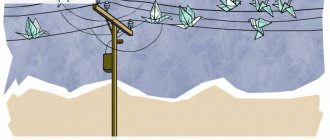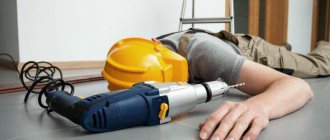Unfortunately, organizing production is a business associated with risk. No one is immune from the occurrence of so-called accidents in these formations - incidents that disrupt any part of the functioning of the enterprise. As a result of their occurrence, as a rule, injuries occur at work. What and when went wrong according to the law must be clarified and explained. To obtain objective information about this, enterprises conduct investigations. The success of these events depends entirely on discipline and compliance with established rules regarding many nuances. Thus, specialized time frames have been established for the investigation of industrial accidents, which we are talking about in today’s article.
Time frames for investigating industrial accidents
Investigation Rules
According to the current classification, industrial accidents are divided into the following two categories:
- lungs;
- heavy.
Whatever happens at the enterprise, if this event fits into the concept of “accident,” it must be investigated in accordance with the procedure established by law. This is about:
- various traumatic injuries;
- thermal, chemical burns;
- frostbite and other health hazards.
The law regulates these incidents and stipulates many important nuances
The investigation itself involves performing a list of the following actions within a certain time frame.
Step #1. First of all, it is necessary to inspect the place where the trouble we are interested in occurred. In addition to independent inspection, the person entrusted with the work presented is obliged to record everything he saw using devices that:
- photography;
- video recording
These digital documents will then become arguments in proceedings
Step #2. It is also necessary to interview citizens - event employees who unwittingly witnessed the industrial incident of interest to you. Questions must be asked dryly and to the point, referring only to events that:
- occurred when the employee was injured;
- led to an accident.
Step #3. Separately, it is necessary to conduct a survey not only of ordinary workers and witnesses to the incident, but also of persons occupying certain leadership positions. The fact is that it is their explanations regarding various aspects of the situation (for example, problems with equipment) that can have an important impact on the further course of the investigation and determining the true causes of what happened.
Step #4. Another task of officials, in addition to the task of finding objective information about what happened, is to familiarize themselves with the documents that are stored in the organization that is the employer. The required papers must be related to the incident and at least partially explain the reasons for what happened. We are talking in particular about how safe working conditions are regulated, which must be ensured by law in production.
Step #5. The last step is to obtain an explanation from the employee who is recognized as a victim. He must describe how and when the emergency occurred, what he believes was involved, and what injuries he sustained.
Video - Industrial accidents subject to investigation and recording
Deadlines and documents
The investigation procedure, in contrast to single accidents with mild injuries, will take 15 days - it is after this period that the formed commission will have to provide results and conclusions. During the investigation, members of the convened commission draw up documents that cover all aspects of the IC and separately represent case materials and interim orders to consider the cause of the incident:
- The order on the basis of which the commission was created;
- Characteristics of the workplace;
- Extracts from the enterprise's occupational safety magazines;
- Protocols for interviewing NS eyewitnesses;
- Expert opinions regarding the consequences and causes of NS;
- Conclusions of a medical examination of the victim, as well as determination of the presence of alcohol or drugs in the blood;
- Copies of documents on the provision of protective clothing to the victim, and so on.
As a result of the investigation, the generated reporting documents will contain the causes of the accident and accompanying circumstances, a list of persons responsible for the incident, approval of the necessary measures as preventive actions, identification of the organization’s employees or third parties who are guilty of the incident and the main conclusion about whether the incident is subject to definition of NS.
Who is responsible for conducting the investigation?
According to the letter of the law, responsibility for investigating industrial accidents involving injuries rests with a specially created commission, which was appointed directly by the employer. This formation may include no less than three persons. If there was a death that resulted from the event of interest to us, a representative of the State Labor Inspectorate joins the employees of the enterprise.
In addition, the following can also take part in this event:
- injured workers;
- their legal representatives.
Registration and investigation
In general, the classification of accidents occurring at work is based on the number of people who are injured as a result of such a fact, that is, if there is only one victim (in any degree of severity), accordingly, he is qualified as a single person, if there are 2 or more persons (regardless of whether the victims are employees of the institution or enterprise), the case will be a group one. In turn, group cases can be divided according to severity into:
- Light, when the victims do not have significant injuries - these could be cuts, scratches, bruises, and so on;
- Severe with worse consequences, such as fractures, damage to internal organs, concussions;
- Lethal, in which the employee dies as a result of the injury.
To investigate group NS, a commission is immediately created (within a working day) that will conduct an investigation and determine why such an incident occurred, as well as who is guilty in such a situation and what is the degree of guilt of each. The commission, which must consist of an odd number of people, includes at least three members, among whom must be:
- Enterprise OT specialist;
- Representatives of the enterprise;
- Persons representing a workers' union;
- State inspector for occupational safety (group NS without his presence cannot be accepted for investigation);
- Representative of the trade union association of the administrative unit of the city, region, and so on.
Additionally, if desired, persons directly affected by the incident can also take part in the investigation, and they can perform this function personally or by providing a power of attorney to represent their interests. Even if the victim himself or a trusted person does not take part in the investigation, then at their first request the employer is obliged to provide all the materials of the case. Separately, among group NS, cases are considered in which the number of victims will be more than 15 people - in this situation, the composition of the commission will already be approved by the Government of the Russian Federation.
Time frame for investigation
How long an investigation can legally take in each case is directly related to the severity of the injuries sustained during the production process by the injured company employee.
The timing of the investigation directly depends on the severity of the incident.
There are two main criteria that the commission uses when determining the severity of the injuries sought. Let's look at them in the table below.
Table 1. Criteria for determining injuries as severe or minor
| Nature of injury | Consequences |
The nature of the injury in this case means whether it is aggravated by any complications. We are talking, for example, about:
| In this situation, the consequences mean the final state of the person who became the central figure in the case of industrial injuries. In other words, if the damage caused to a person goes away sooner or later, or does not affect his quality of life, the consequences are considered to be minimal. However, if long-term or permanent disability occurs, the accident is “rewarded” with the highest degree of severity. |
You can find out more about these criteria in the Order of the Ministry of Health and Social Development.
Now let's turn to the main topic that interests us today - the timing of the investigation of accidents in production conditions. Under the influence of the criteria we have already mentioned, they may be as follows.
- For cases in which it has been determined that the harm caused to the health of an employee of the enterprise is classified as minor, the investigation period is three days from the moment of its initiation.
- If the incident nevertheless fell into the category of incidents that entailed serious consequences, seriously worsening the health status of the citizen injured at work, the duration of the investigation can last up to 15 days from the moment it began.
- In the event that the head of production was not notified in a timely manner about what happened at the enterprise under his supervision, the time frame provided for the investigation may be increased and amount to as much as 20 days from the day the news about the incident was received.
All of the above deadlines, if there are circumstances that make the situation out of the ordinary, can potentially be extended by an additional 15 days.
Article 229.1. Time frame for accident investigations
In this case, this extension must be accompanied by the manager:
- issuance of the relevant order;
- reflection within this document of the reasons that determined the need to use an additional time period.
By the way, the reasons under discussion may include the following circumstances.
- First of all, additional time may be needed to find out the circumstances that require additional checks.
- In some cases, it may be necessary to: obtain a medical examination (including for the surviving victim);
- obtaining examination data, during which, for example, work equipment that turned out to be faulty was examined, etc.
- technical equipment;
Sometimes it happens that even an additional 15-day period is barely enough to complete all required activities.
All the deadlines listed above are required by law to be counted in calendar days. You must begin calculating the period you are interested in from the date when:
- a corresponding order was issued;
- an investigation into the incident has been initiated;
- a special commission was appointed.
Procedure for investigating industrial accidents
The procedure for investigating industrial accidents is established by Article 229 of the Labor Code of the Russian Federation.
To investigate an accident, the employer immediately creates a commission of at least three people, which is headed by the employer or his authorized representative. The composition of the commission is approved by order (instruction) of the employer; the commission includes:
- a labor protection specialist or a person appointed responsible for organizing labor protection work by order (instruction) of the employer;
- employer representatives;
- representatives of the trade union body or other representative body authorized by employees, the Occupational Safety and Health Commissioner.
It should be taken into account that the manager directly responsible for labor safety at the site (facility) where the accident occurred is not included in the commission.









